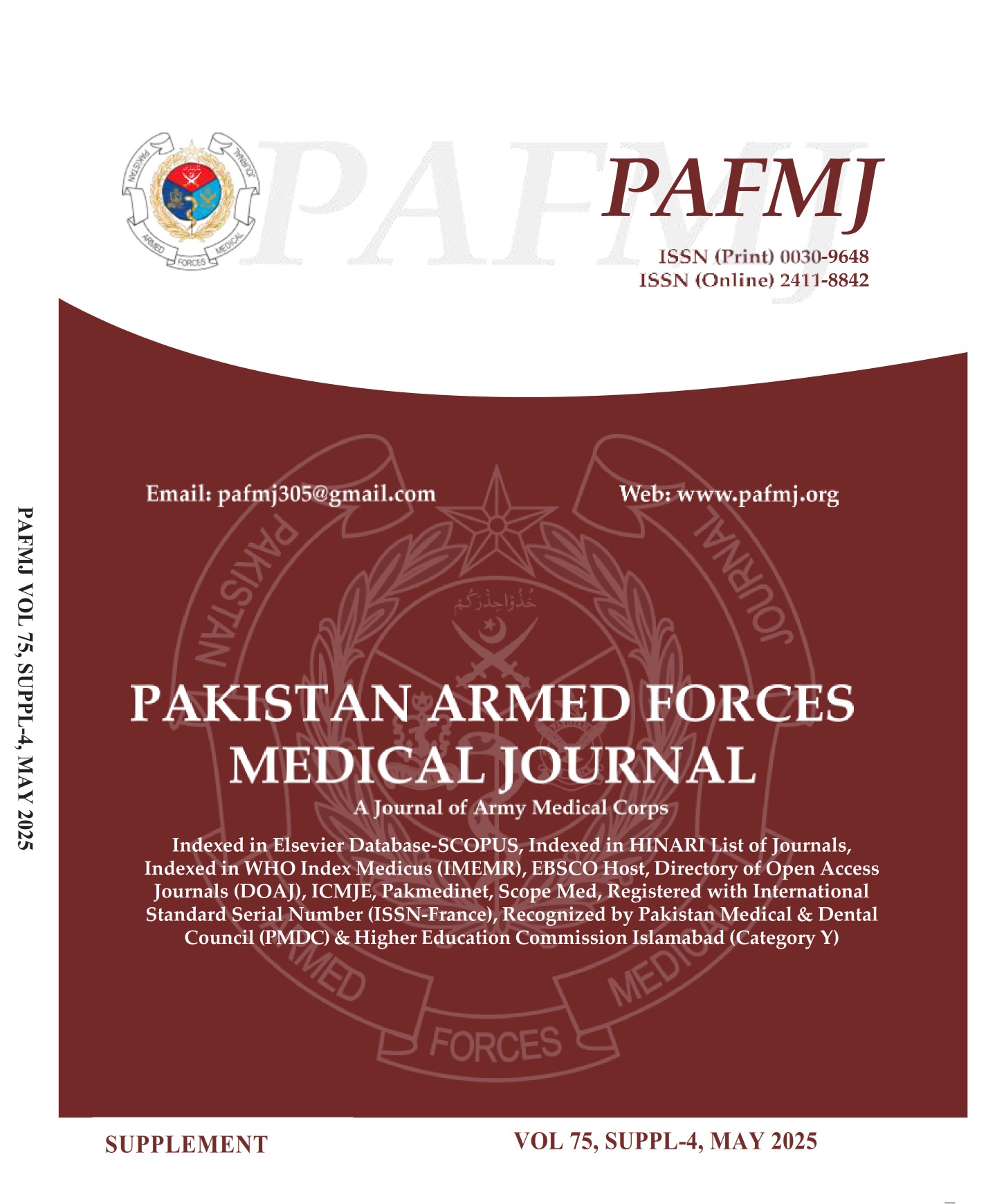Socio-Demographic Correlates of Positive Youth Development In Adolescents, Pakistan
DOI:
https://doi.org/10.51253/pafmj.v75iSUPPL-4.6910Keywords:
Adolescent Development, Adolescent Health, Economic Development, Well-Being, Welfare.Abstract
Objective: To explore the impact of socio-demographic correlates in positive development of adolescents.
Study Design: Cross-sectional study
Place and Duration of Study: Department of Psychology, University of Gujrat, Gujrat Pakistan, from Feb to May, 2019.
Methodology: In Phase I, The Positive Youth Development Inventory (PYDI) was translated into Urdu by forward-backward translation method. Urdu version of PYDI was administered on 130 students selected by random sampling technique to check the accuracy of comprehension in Urdu and its reliability (α=85). In Phase II, Stratified Random Sample of 608 students (16 to 19 years) from private and public colleges of Sarai Alamgir was selected. Demographic sheet along with PYDI was administered on the students. The data was analysed in SPSS-21 version.
Results: In neural network multilayer perceptron analysis, the difference in training and testing relative error was 0.013 average mean, indicating significant contribution of predictive relationship of socio-demographic variables with positive development in youth. The predictive individual normalized importance of gender, monthly income, class, institution type, age, residential area, academic profession, and family system was 100%, 92.7%, 63.4%, 60.5%, 56.6%, 29%, 24.3%, and 9.9% respectively in the healthy development of youth.
Conclusion: Gender of adolescents along with socio-economic status based on monthly income plays a significant role in predicting positive development of their personality. This implied for implantation of any youth development intervention plan while keeping in view the perspective of gender and socio-economic status.
Downloads
References
Lerner RM, Lerner JV, Bowers EP, Geldhof GJ. Positive youth development and relational-developmental-systems. In Handbook of Child Psychology and Developmental Science: Theory and Method. eds W. F. Overton, P. C. M. Molenaar, and R. M. Lerner. New York: John Wiley & Sons, Inc, 607–651. 2015.
Shek DT, Zhu X, Leung JT, Lee TY, Wu FK. Evaluation of the Project PATHS in mainland China: Findings based on student diaries. Research. Res. Soc. Work Pract. 2019 May; 29(4): 410-9. https://doi: 10.1177/1049731517745994
Zhou Z, Shek DT, Zhu X. The importance of positive youth development attributes to life satisfaction and hopelessness in mainland Chinese adolescents. Front. Psychol. 2020 Sep 30; 11: 2599.
Huebner ES, Drane W, Valois RF. Levels and demographic correlates of adolescent life satisfaction reports. Sch. Psychol. Int. 2000 Aug; 21(3): 281-92.
Marcenaro–Gutierrez O, Lopez–Agudo LA, Ropero-García MA. Gender differences in adolescents’ academic achievement. Young. 2018 Jun; 26(3): 250-70.
Crocetti E, Moscatelli S, Kaniušonytė G, Meeus W, Žukauskienė R, Rubini M. Developing morality, competence, and sociability in adolescence: a longitudinal study of gender differences. J Youth Adolesc. 2019 May; 48(5): 1009-21.
United Nations Development Program. Pakistan National Human Development Report. 2020. Available from http://www.pk.undp.org. [Accessed on April 26, 2021].
Hafeez E, Fasih T. Growing Population of Pakistani Youth: A Ticking Time Bomb or a Demographic Dividend. Int. J. Educ. Dev. 2018 Dec; 5(2): 211-26.
Wiium N, Dimitrova R. Positive youth development across cultures: introduction to the special issue.Child Youth Care Forum. 2019; 48(2): 147–153.
https://doi:10.1007/s10566-019-09488-7.
Shek DTL. The role of positive youth development and family functioning in Chinese adolescent well-being: theoretical considerations and empirical evidence. In: Maggino F, editor. A Life Devoted to Quality of Life. Cham, Switzerland: Springer; 2016: 43–60.
https://doi:10.1007/978-3-319-20568-7
Arnold ME, Nott BD, Meinhold JL. The positive youth development inventory full version. Manuscrito nao pulicado. Oregon State University, Corvallis, USA. 2012. Available at: https://youthrex.com/wp-content/uploads/2019/10/Positive-Youth-Development-Inventory.pdf. [Accessed on January 2, 2019].
Yamane T. Statistics: An introductory analysis. 2nd edition. New York: Harper and Row. 1967.
Ahmad S. Unleashing the potential of a young Pakistan. United Nations Development Programme: Human Development Reports. 2018. Available at:
http://hdr.undp.org/en/content/unleashing-potential-young-pakistan. [Accessed on May 6, 2019].
Ashraf D, Ali T, Hosain A. Youth development and education in Pakistan: Exploring the relationship. Sisyphus – J. of Edu. 2013; 1(2): 162–192.
Parajuli M, Thapa A. Gender Differences in the Academic Performance of Students. J. Dev. Soc. Eng. 2017 Dec 2; 3(1): 39-47.
Ma ZW, Zeng WN, Ye KY. Gender differences in Chinese adolescents' subjective well-being: the mediating role of self-efficacy. Psychol.Rep. 2015 Feb; 116(1): 311-21.
Van der Graaff J, Carlo G, Crocetti E, Koot HM, Branje S. Prosocial behavior in adolescence: gender differences in development and links with empathy. J. Youth Adolesc. 2018 May; 47(5): 1086-99.
Cicognani E, Zani B, Fournier B, Gavray C, Born M. Gender differences in youths’ political engagement and participation. The role of parents and of adolescents’ social and civic participation. J.Adolesc. 2012 Jun 1; 35(3): 561-76.
Yasmin KH, Taghdisi MH, Nourijelyani K. Psychological Well-Being (PWB) of school adolescents aged 12–18 yr, its correlation with general levels of Physical Activity (PA) and socio-demographic factors in Gilgit, Pakistan. Iran.J. Public Health. 2015 Jun; 44(6): 804-809.
Zulfiqar A, Syed FR, Latif FF. Developing a student well-being model for schools in Pakistan. Improv. Sch. 2019 Mar; 22(1): 86-108-111.
Levin KA. Urban-rural differences in adolescent mental health and wellbeing in Scotland. J. Epidemiol. Community Health. 2014; 68(1): 68-69.
Beri N, Jain M. Personal growth initiative among undergraduate students: Influence of emotional self efficacy and general well being. Rupkatha J. Interdiscip.Stud.Humanit. 2016 Jan 1; 8(2): 43-56.
Riaz L. Students’ structural empowerment and their well-being at university level. (Doctoral dissertation). Department of Education. The Islamia University of Bahawalpur. 2015.
Shek DTL, Liang LY. Psychosocial factors influencing individual well-being in Chinese adolescents in Hong Kong: a six-year longitudinal study. Appl. Res. Qual. Life. 2018; 13: 561–584. https://doi: 10.1007/s11482-01 7-9545-4
Moore KA. Commentary: positive youth development goes mainstream.Child Dev. 2017; 88(4): 1175–1177. https://doi:10.1111/cdev.12874
Downloads
Published
Issue
Section
License
Copyright (c) 2025 Sameera Shafiq, Sidra Batool

This work is licensed under a Creative Commons Attribution-NonCommercial 4.0 International License.















